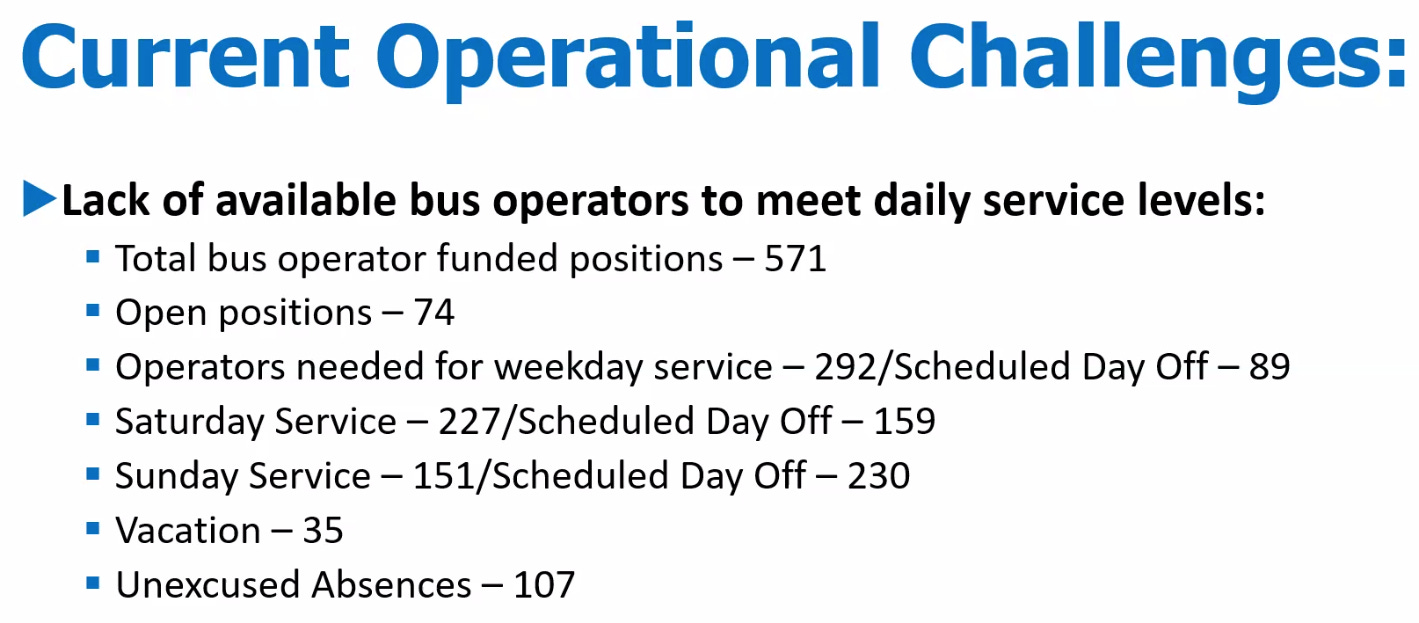Support in-depth, original, independent local news with a paid subscription to The Charlotte Ledger:
You’re reading Transit Time, a weekly newsletter for Charlotte people who leave the house. Cars, buses, light rail, bikes, scooters … if you use it to get around the city, we write about it. Transit Time is produced in partnership among The Charlotte Ledger, WFAE and the UNC Charlotte Urban Institute.
As bus riders slam ‘unconscionable’ late and no-show buses, CATS CEO blames union rules and worker shortage; says driver contract allows 40 paid sick days a year
Passengers wait for their buses on Wednesday afternoon at the Charlotte Transportation Center uptown. Riders are growing increasingly frustrated with late and missing buses, which the Charlotte Area Transit System (CATS) says stem from a driver shortage and from drivers calling in sick.
by Tony Mecia
CATS chief John Lewis on Wednesday shed new light on the reasons that his transit agency’s buses increasingly are late or don’t show up, saying that drivers using their allotted paid sick days are leaving the agency without enough workers to operate routes and contributing to unreliable service.
At a meeting of elected officials from around the Charlotte region, Lewis said CATS’ challenges keeping buses running on time spring from a “confluence of an aligning of stars in the most negative way” — factors that include trouble hiring new drivers, ramping up service after Covid and what he called a “loophole” in union contracts that allow drivers to call in sick, with full pay, 10 days per quarter without consequence. That’s in addition to vacation time.
CATS is authorized to have 571 bus drivers, but as of Wednesday, 74 positions were unfilled. Some 292 drivers are needed each weekday, and on Wednesday, 107 called in sick — more than 1/5 of the system’s drivers. Lewis warned that service cuts could be coming, including slashing weekday service to Saturday levels for several months.
“We are having challenges providing reliable service each day,” Lewis said. “… We must close the attendance policy loopholes that are allowing 107 bus operators to call out on days like today without discipline.”
A slide presented at Wednesday’s Metropolitan Transit Commission illustrates the shortages of bus drivers that is contributing to substandard service.
Although North Carolina law prohibits labor unions for public employers, federal law protects collective bargaining rights of transit workers. CATS bus drivers don’t work directly for CATS. Instead, they work for a CATS contractor called RATP Dev USA, which has worked with CATS since 2003. The system’s bus drivers are represented by the International Association of Sheet Metal, Air, Rail and Transportation Workers, or SMART Union. A union representative didn’t reply to an inquiry from Transit Time on Wednesday.
Lewis’ explanation of driver shortages comes as bus riders are becoming increasingly frustrated waiting for buses that never come — buses they rely on to get to work or to doctors’ appointments.
Riders says bus system is ‘in shambles’ … ‘it’s just insane’
At the Charlotte Transportation Center (CTC) uptown on Wednesday afternoon, several people waiting for buses didn’t hold back in their criticisms of bus service they use frequently.
“It’s in shambles right now,” said Andre Williams, 54, a retired sportswriter from Pennsylvania who moved here more than a decade ago after suffering a stroke. He was heading to OrthoCarolina on Randolph Road, after catching the No. 17 bus to uptown from his home off Briar Creek Road. “Bus drivers don’t want to work. The No. 17 is ridiculous. Sometimes it comes, sometimes it doesn’t.”
He said he sometimes waits an hour or more for the No. 17, which CATS’ schedule shows is supposed to run every 30 minutes on weekdays. He says he thinks the answer is for CATS “to hire some more drivers — some committed drivers. It’s scorching hot outside. Nobody wants to wait at the bus stop dripping sweat.”
Greg Lilly, 28, said he’s been late to work several times, after the No. 27 bus he takes to get to work at a pizza place uptown from Monroe Road is chronically behind schedule or doesn’t arrive at all. Since he moved here from West Virginia two months ago, he estimates the No. 27 hasn’t shown up at least a dozen times.
“It’s just insane,” he said. “I don’t know — every city is working on public transportation, so I’m not bitching. But I think we could do a little better.”
Asked what the bus system could do to improve, he said: “Show up on time. Or showing up at all would be great. … We should be able to get where we are going.” He said he found public transit in West Virginia to be more efficient.
Ridership falling: Driver absences are not a new problem for CATS: In February, Lewis told Transit Time that the agency was averaging more than 100 unscheduled absences a day. But the reliability problems could be eating into CATS’ ridership. Statistics for last month show that the number of passengers riding local buses in Charlotte was down 15% from May 2021 — even as gas prices rose and the pandemic receded. Even more amazingly, local bus ridership last month remained below the levels for May 2020, during the depths of the pandemic, when the state was under a stay-at-home order for most of the month.
Although the numbers are down, many Charlotte residents still rely on public transit to get around town.
CATS statistics show that:
78% of bus riders are Black
63% are commuting to work
47% earn less than $25,000 per year
The struggles seem to have gotten worse in the last few months, following the February shooting death of a driver by a motorist uptown in an apparent road rage incident. Another rider fired shots at a bus last month after a confrontation with a driver, and drivers have said they don’t feel safe.
‘Everyone was frustrated’
At Wednesday’s meeting, Krissy Oechslin, chair of CATS’ Transit Services Advisory Committee, told of her experience Sunday at the bus station uptown, where she and others waited for two hours for the No. 9 bus to east Charlotte that was supposed to run every 30 minutes.
“Many people were waiting, and everyone was frustrated — people just trying to go home after their shifts working at a hotel or other businesses uptown,” she said.
One woman in a mobility scooter, she said, waited nearly two hours for a bus after having already taken the light rail and another bus. Oechslin said she paid for a Lyft ride for the woman because “it was unconscionable to strand her at the CTC for hours.”
Earlier in the week, she had written about the experience on Twitter. That drew a reply from Lewis, who called it “absolutely unacceptable!” and said, “That’s on me!”:


Lewis said he’s hopeful that a new union contract will provide more flexibility.
“The solution to this is higher salaries, better scheduling and closing the attendance policy loopholes that allow so many people to call off on a day-to-day basis,” he said. He added that CATS could also consider reducing service on weekdays to Saturday levels for several months.
Some members of the regional transit panel told Lewis they were astonished that CATS bus drivers are allowed 40 days of paid sick leave each year.
“Wow, 40 per year?” said Matthews Mayor John Higdon. “Nothing I’ve ever been involved in would allow an employee to lay out 40 days a year and maintain their employment. That’s excessive, in my view.”
Lewis replied: “Absolutely.”
Decision close on site of new South End light rail stop
Officials with the Charlotte Area Transit System say they’re getting close to recommending a location for a new Lynx Blue Line light rail stop in South End.
At a meeting on Wednesday, officials said they are considering three options:
a “north option,” between Atherton Lofts and the current site of Sycamore Brewing
a “south option” between the Publix and the Spectrum apartments
an “offset option” that splits the two platforms, with the southbound platform by Sycamore and the northbound platform by the Publix
A new light rail stop between the East-West and New Bern stations in South End would serve a heavily developed area. One option is to split the location of the platforms.
Each one has potential drawbacks, planners said, such as the need to relocate stormwater drains or reconfigure the Rail Trail. But nearby property owners have requested a new stop, and CATS would like to find a way to enhance pedestrian safety. People often cross the tracks in that heavily developed area.
“There is fencing along the corridor, but people climb the fence,” CATS development director Kelly Goforth said.
Staff hopes to have a recommendation by July 1, followed by a series of presentations and public meetings. The existing timeline calls for the new stop to open in late 2026. —Tony Mecia
Transit Time is a production of The Charlotte Ledger, WFAE and the UNC Charlotte Urban Institute. You can adjust your newsletter preferences on the ‘My Account’ page.
Did somebody forward you this newsletter and you need to sign up? You can do that here:
Other affiliated Charlotte newsletters and podcasts that might interest you:
The Charlotte Ledger Business Newsletter, Ways of Life newsletter (obituaries) and Fútbol Friday (Charlotte FC), available from The Charlotte Ledger.
The Inside Politics newsletter, available from WFAE.
The UNC Charlotte Urban Institute newsletter and the Future Charlotte podcast from the Urban Institute.










“40” sick DAYS? Many companies only provide 40 Hours. Pay people to not work, and you get what you pay for.
Leadership at CATS is ultimately at fault. The buck stops there. There must be a way to eliminate RATP Dev USA as the entity that hires bus drivers. Without being able to make driver’s accountable for taking excessive sick days, the system will never improve. When city council adopts policies for increased growth, those policies will just result in increased gridlock and unfairness to persons who must use public transit. Other cities such as Pittsburgh PA have a reliable bus system. Why can’t Charlotte in a state that is infamous for discouraging unions.